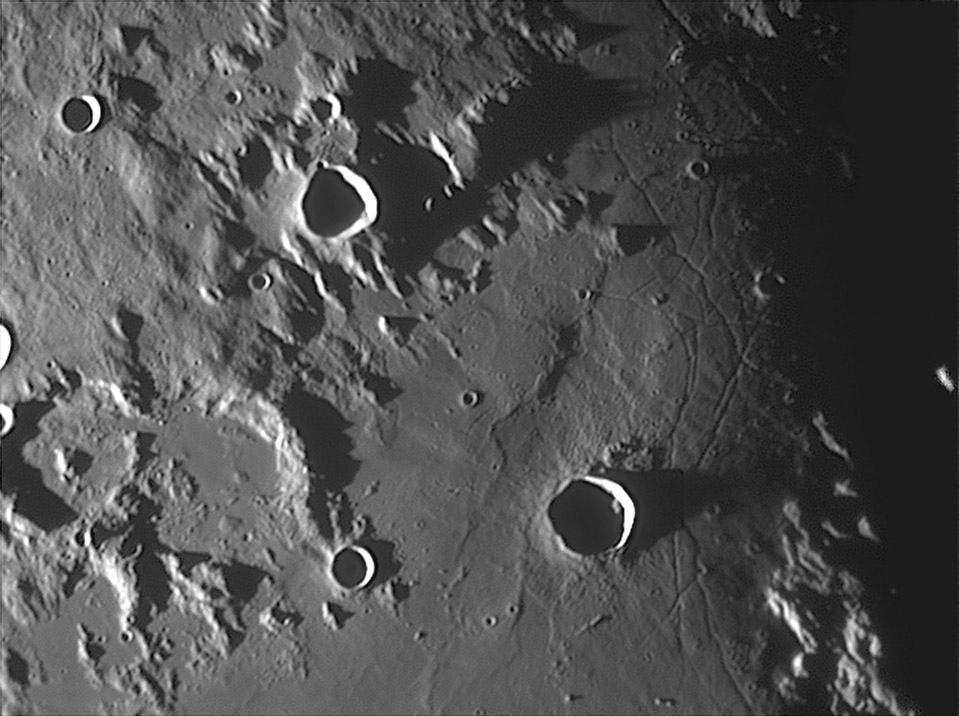|
|
| (11 intermediate revisions by the same user not shown) |
| Line 1: |
Line 1: |
| | __NOTOC__ | | __NOTOC__ |
| | =Continuing East= | | =Continuing East= |
| | + | <!-- Start of content --> |
| | + | <div class="post" id="post-685"> |
| | | | |
| − |
| + | <div class="storycontent"> |
| − | <div class="post" id="post-685">
| + | <p>[[File:06_10_14_04_33_15_Triesnecker_Lammel.jpgs.jpg|06_10_14_04_33_15_Triesnecker_Lammel.jpgs.jpg]]<br /> |
| − |
| |
| − | <div class="storycontent">
| |
| − | <p>[[File:06_10_14_04_33_15_Triesnecker_Lammel.jpgs.jpg|06_10_14_04_33_15_Triesnecker_Lammel.jpgs.jpg]]<br />
| |
| | <em>image by [mailto: Stefan Lammel], Uxbridge, England</em></p> | | <em>image by [mailto: Stefan Lammel], Uxbridge, England</em></p> |
| − | <p>Continuing east from yesterday’s LPOD takes us to one of the classic, but poorly understood, features on the Moon. Triesnecker is a 26 km wide complex crater whose ejecta is draped over the adjacent smooth terrain, but the feature of interest is a labyrinth of narrow linear rilles to the east. I don’t know why the rilles are here. Some rilles in other parts of the Moon are surface expressions of volcanic dikes (or dykes as spelled in UK); if these are also, the question is why was there such a concentration of dikes in this region? The low lighting and high resolution of Stefan’s shot emphasizes the undulating ground that the rilles cut. West of Triesnecker is a shallow depression that seems to be a broad [http://www.lpod.org/archive/LPOD-2004-07-25.htm valley] covered by whatever the smooth material is (wait for tomorrow).</p> | + | <p>Continuing east from yesterday’s LPOD takes us to one of the classic, but poorly understood, features on the Moon. Triesnecker is a 26 km wide complex crater whose ejecta is draped over the adjacent smooth terrain, but the feature of interest is a labyrinth of narrow linear rilles to the east. I don’t know why the rilles are here. Some rilles in other parts of the Moon are surface expressions of volcanic dikes (or dykes as spelled in UK); if these are also, the question is why was there such a concentration of dikes in this region? The low lighting and high resolution of Stefan’s shot emphasizes the undulating ground that the rilles cut. West of Triesnecker is a shallow depression that seems to be a broad [[July_25,_2004|valley]] covered by whatever the smooth material is (wait for tomorrow).</p> |
| | <p>[mailto:tychocrater@yahoo.com Chuck Wood]</p> | | <p>[mailto:tychocrater@yahoo.com Chuck Wood]</p> |
| | <p><strong>Technical Details:</strong><br /> | | <p><strong>Technical Details:</strong><br /> |
| Line 14: |
Line 13: |
| | <p><strong>Related Links:</strong><br /> | | <p><strong>Related Links:</strong><br /> |
| | Rükl chart 33<br /> | | Rükl chart 33<br /> |
| − | [http://www.slamm.pwp.blueyonder.co.uk/moon/moon.htm Stefan’s website]<a /a></p> | + | [http://www.slamm.pwp.blueyonder.co.uk/moon/moon.htm Stefan’s website]</p> |
| − | <div align="center"><em>LPOD earns a commision when you buy ANY book from Amazon thru [http://www.lpod.org/?page_id=102 LPOD!]<br /> | + | <p><b>Yesterday's LPOD:</b> [[November 2, 2006|Move Over Orbiter]] </p> |
| − | </em></div> | + | <p><b>Tomorrow's LPOD:</b> [[November 4, 2006|Digging Below the Surface]] </p> |
| − | <p></a></p> | + | </div> |
| − | </div>
| + | <p> </p> |
| − |
| + | <p> </p> |
| − | | + | <p> </p> |
| − | ---- | + | <!-- End of content --> |
| − | ===COMMENTS?===
| + | {{wiki/ArticleFooter}} |
| − | Click on this icon [[image:PostIcon.jpg]] at the upper right to post a comment.
| |




